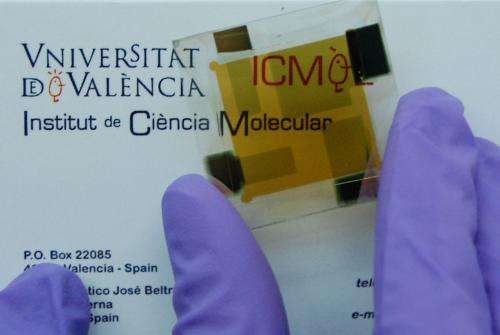Team creates a low cost thin film photovoltaic device with high energy efficiency

A group of researchers led by Hendrik Bolink of the Institut de Ciència Molecular (ICMol) of the Scientific Park of the University of Valencia has developed a thin film low cost photovoltaic device with high power conversion efficiency. The results of this work, done in collaboration with researchers of École Polytechnique Fédérale de Lausanne (EPFL) in Switzerland, were published in the scientific magazine Nature Photonics.
The solar cell developed by the researchers of the ICMol consists of a thin perovskite film sandwiched in between two very thin organic semiconductors. The total thickness of the device is less than half a micrometer, less than a millions' part of a meter. The hybrid organic-inorganic perovskite material can be prepared easily and at low cost. Hendrik Bolink explains that these devices were prepared with low temperature processes similar to those used in the printing industry which allows the use of plastic substrates such that flexible devices can be prepared.
It is also possible to make the device semitransparent which allows their integration with building facades since they are very thin and light weight. In this way the sun light is filtered protecting the building interior from intense sun light while at the same electricity is generated.
An 85% of the solar cells that convert sun light into electricity are based on crystalline silicon, an expensive material, whereas the rest use polycrystalline thin film cells, mostly cadmium telluride/cadmium sulfide. These thin film cells are cheaper to produce yet are based on rare and rather toxic elements. Therefore, "the demonstration of high efficiency in thin film solar cells based on abundantly available and cheap materials like as used in these perovskite based solar cells, allows for an increasing share of solar energy in the mix of renewable resources" according to Dr. Bolink.
Dr. Bolink obtained his PhD in Materials Science at the University of Groningen, The Netherlands in 1997. He worked at the chemical multinational DSM as a materials scientist and project manager in the central research and new business development department, respectively. In 2001 he joined Philips, to lead the materials development activity of Philips´s PolyLED project.
Since 2003 Dr. Bolink is at the ICMol of the University of Valencia where he initiated a research line on molecular opto-eletronic devices. He has published 125 scientific papers in international journals and has been main scientist in eleven European research projects, currently three of them are still active.
More information: Perovskite solar cells employing organic charge transport layers. O. Malinkiewicz, Y. Aswani, Y. H. Lee, M. Minguez Espallargas, M. Graetzel, M. K. Nazeeruddin and H. J. Bolink. Nature Photonics DOI: 10.1038/nphoton.2013.341
Journal information: Nature Photonics
Provided by Asociacion RUVID




















